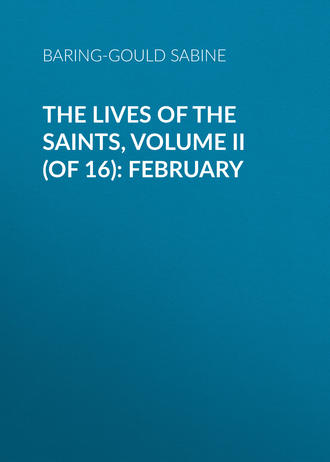
Baring-Gould Sabine
The Lives of the Saints, Volume II (of 16): February
To the new king, as well as to his sister, the Abbess Elfleda, Archbishop Theodore of Canterbury wrote, to exhort them both to lay aside their enmity against Wilfrid, and to receive him with unreserved kindness. They yielded, and recalled Wilfrid, but were mistaken in supposing that age had altered his determination. He returned in 687 to excite storms throughout his diocese, and was again exiled, in 691.
Aldfrid died in 705, and the Northumbrian crown descended to a prince named Eadwulf. Wilfrid had taken advantage of the death of Aldfrid to return to Ripon, but was ordered to leave the country in six days. But Eadwulf was dethroned, and a son of Aldfrid, Osred, aged eight, was given the realm of Bernicia, the counties of Northumberland and Durham. By means of some mysterious influence, the nature of which is unknown, the aged exile Wilfrid, who had been expelled from the country for fourteen years, and was to all appearance forgotten, became, all at once, the master of the situation, and the arbiter of events. He soon acquired a more powerful protector than the young sovereign in the person of Earl Bertfrid, who was considered the most powerful noble in the kingdom, and who was at the head of Osred's party. King Eadwulf marched against the insurgents, and obliged them to retreat to the fortress of Bamborough, where the earl, shut up in the narrow enclosure of this fortified rock, and reduced to the last extremity, vowed that, if God would deliver him and his charge, the young prince and his people should bow to the Roman subjection. An opportune desertion of Eadwulf's followers gave victory to Bertfrid, and Eadwulf was exiled after a short reign of two months. As soon as the royal child was placed on the throne, the Archbishop of Canterbury made his appearance, perceiving that the time was come for reinstating Wilfrid, and settling his affairs in a general assembly. This was held in the open air on the banks of the Nid. Wilfrid was present, and met there Bertfrid and the Abbess Elfleda, who had come over to his side, and to Roman obedience. All the Northumbrians regarded her as the consoler and best counsellor of the kingdom. The bishops and abbots present opposed the claims of Wilfrid, and refused to accept him, though he came armed with the authority of the Holy See. At this point, the Abbess Elfleda interposed: in a voice which all listened to as an utterance from heaven, she described the last illness and agony of the king her brother, and how he had vowed to God and S. Peter to accomplish the papal decrees which he had so vigorously rejected. "This," she said, "is the last will of Aldfrid the king; I attest the truth of it before Christ." Bertfrid afterwards spoke and announced his vow. Nevertheless the three bishops would not yield, they retired from the assembly to confer among themselves, and with Archbishop Britwald, but above all with the sagacious Elfleda. Thanks to her, all ended in a general reconciliation.
Shortly before his death, and during his last pastoral visitation, S. Cuthbert went to see Elfleda in the neighbourhood of the great monastery of Whitby, to consecrate a church which she had built there, and to converse with her for the last time. They dined together, and during the meal, seeing his knife drop from his trembling hand in the abstraction of supernatural thoughts, she had a last opportunity of admiring his prophetic intuition, and his constant care for the salvation of souls. The fatigue of the holy bishop, who said laughingly, "I cannot eat all day long; you must give me a little rest"; the eagerness and pious curiosity of the young abbess, anxious to know and do everything, who rushed up breathlessly during the ceremony of the dedication to ask the bishop a memento for a monk, whose death she had just heard of, – all these details, says a modern writer,27 form a picture complete in its simplicity, upon which the charmed mind can repose amid the savage habits and wild vicissitudes of the struggle, then more violent than ever, between the Northumbrians and Picts, the Saxons and the Celts.
S. Elfleda died at the age of sixty. No account of her last illness has been transmitted to us.
S. MENGOLD, M
(ABOUT A.D. 892.)
S. Mengold, second patron of the town of Huy on the Meuse, where a church is erected under his invocation, was count of Huy, and was murdered by some knights of his court, whose vices he attempted to restrain.
His relics, along with those of several other saints of Huy, are preserved in the noble church of Our Lady in that town.
S. CUTHMAN, C
(DATE UNCERTAIN.)
[In Ancient Anglo-Saxon Kalendar belonging to the Abbey of Fécamp, and French Martyrology. Authority: – Two lives of uncertain date, by anonymous writers.]
The blessed Cuthman was by birth a native of Devonshire or Cornwall, and his youth was spent in pasturing his father's sheep on the granite moors. One day, when dinner time came, he was hungry, and not having a companion to whom he could entrust his flock during his absence, he drew a circle in the heather and gorse with his staff, and then planted it in the soil, and said, "In the name of our Lord Jesus Christ, I command you sheep not to transgress the bounds I have drawn, till I return from my dinner." And, wonderful to relate, the sheep obeyed his command. Now there was a grey moorstone on which he was wont to sit; and this moorstone has been ever since regarded with singular veneration, says the ancient writer of his life.
After some years his father died, and the widow was reduced to great poverty. Cuthman ministered to her with the tenderest care and filial devotion, and worked for their joint subsistence. When the poor woman fell sick, he was unable to leave her, at the same time he was so destitute that, unless he went forth to work or beg, they must starve. He, therefore, contrived a wooden truck or barrow on two wheels, and laid his mother on it, and went behind, thrusting her on with his hands, and supporting her by a rope slung round his neck, and begged from door to door, as her condition incapacitated him from working. One day, as he was thus thrusting his little cart through a field where the hay-makers were mowing the grass, the rope broke, and the holy youth stood a while hesitating what to do. Then he tore from an elder tree a bough, and twisted it, and attached it to his mother's cart, and supported it therewith. But the mowers laughed at him as a fool for endeavouring to supply the place of a rope with hollow elder wood. Their mockery was, however, soon arrested by a pelting rain, which drove them from their work, and by seeing the bough hold as firmly as a rope.
And when Cuthman saw that God assisted and avenged him, he vowed to build a church to his holy Name. But how to do so he knew not. So he continued his wanderings, ever journeying East way, and thrusting his mother before him, till he came to Steyning, in Sussex, where the rope suddenly broke, and his mother was much shaken, but, mercifully, was not injured. Then he thought that this was to be the place of his rest, and he said, "O Lord, on me has fallen to undertake the work of building Thee a house; for to do this thou didst inspire me with the will. Whither shall I fly from Thy Spirit? This is the place where I shall finish my wanderings, this shall be my habitation, in which I shall offer and pay Thee my vows, day by day. Almighty Father, who hast brought my journey to an end, bless my work of building to thee a temple. Thou knowest how poor I am, and a labourer from my youth, and of myself I can do nothing, unless thou dost succour me."
The place was still and solitary, trees surrounded it, and hard by flowed the tidal river Adur. The land was little populated; here and there only a farm, buried in a nook of the great chalk downs. He chose a spot at the foot of these downs, and there he built a hut and laid his poor mother in it, and at once began to measure out the ground for his proposed church. He found favour with the people round about, and they contributed to his sustenance and the support of his mother, as they watched him single-handed dig the foundations, cut the timber, and rear the walls of the church he had vowed to God. He was given two oxen to help him in his work of carrying stones. Now, one day, these oxen strayed into the field of a woman who had two grown up sons. The young men at once seized on the oxen, and took them into their house. Cuthman went after the oxen, and when he could not find them, asked the young men for them, but they refused to surrender them. Then he said angrily, "I need them not to do my own work, but to labour for God. See I have laded my cart with those logs, and must move them to the house of God. Come then you and draw them." And he grasped the youths, and yoked them to the wain, and made them drag the stones to their destination.
Now as the church approached completion, Cuthman was grieved one day to find that a wooden pillar he had set up, was bent with the weight imposed upon it, and he feared to remove it, lest he should bring down a part of the building. Then there came a traveller to the door, of very grave and beautiful aspect, and asked Cuthman why he was troubled. And Cuthman pointed to the bent post. Then said the stranger, "O man of little faith! to those who fear God, nothing is impossible. Stretch forth thine hand and let me help thee, and we will straighten it." And he did so, and the pillar became upright. Then Cuthman fell at the stranger's feet, and said, "My lord, tell me thy name!" And he answered, "I am Jesus, to whom thou buildest this house;" and so vanished.
Now Cuthman not only built and laboured for his old bed-ridden mother, but he also preached to the people, and stirred up the love of God, and zeal for His commandments in their hearts. And as his church approached completion, he was glad, and he worked without, and then rested for a while in prayer within. And chipping at the logs without, he wore thick gloves, and when he went within he took off his gloves, and hung them on a little ray of light that pierced through one of the small windows he had made in the walls. And there, where he worked, he died, but what was the nature of his illness, and his disposition at death is not recorded. He was buried at Steyning, and the Adur, then navigable as far as this place, long bore the name of S. Cuthman's Port. Steyning was given by Edward the Confessor, and afterwards by the Conqueror, to the abbey of Fécamp, in Normandy, from which circumstance Bollandus supposed Steyning was in Normandy, and many have been misled thereby. The church of Steyning, dedicated to S. Cuthman, was built by monks of Fécamp to replace his wooden one.
The Monasticon Anglicanum of Dugdale, (II. p. 992), Leland, Collect. I. p. 96; II. p. 409; III. p. 82; and Camden asserts plainly that S. Cuthman was buried at Steyning in Sussex. "Cella de Stening Nigrorum Monachorum in quâ sepultus Stus. Cudman;" "S. Cudmannus in Stenig prope Brambre flumen." "Stus. Caudmannus in loco qui dicitus ad Staning requiescit prope amnem Brembre;" this Brembre is Bramber; the name is no longer given to the river, but to the castle hard by, upon it.
S. STEPHEN OF GRANDMONT, AB
(A.D. 1124.)
[Roman Martyrology. Authority: a life by Gerald Itherius, prior of Grandmont.]
S. Stephen was born in the year 1046, in the castle of Thiers, in Auvergne, belonging to his father, the Viscount de Thiers. At an early age of twelve he was taken by his pious father a pilgrimage into Italy. On their return, the lad fell ill at Benevento, and the father was obliged to leave him in the charge of Milo, archbishop of that city, a native of Auvergne. This prelate took the greatest care of the young Stephen and reared him in all holy lore; and as he grew up intent on serving God in a spiritual and ecclesiastical state, he ordained him, first sub-deacon, and afterwards deacon.
After the death of the archbishop, Stephen, being then twenty-four years old, went to Rome and remained there four years. There the vocation to the religious life growing stronger in him, he formed the resolution of imitating certain monks of Calabria, living in great holiness, of whom he had heard Milo speak, and whom he had once visited. He therefore asked permission of Pope Gregory VII. to live apart in some solitude, following the rule of the Calabrian hermits. The pope hesitated for some while, thinking him too delicate of constitution, but at length yielded to his pressing solicitations in 1073. Stephen then returned to France, and resided at Thiers for a short time with his parents; and then, departing, established himself at Aureille or Soviat, a few leagues from Limoges, where he placed himself under the direction of S. Gaucher, who had built a monastery of regular Canons, called S. Jean d'Aureille. But S. Gaucher having erected a nunnery in the neighbourhood, S. Stephen disliking the proximity to women, left Aureille, and retired to Muret, in 1076. This is a mountain near Limoges, where, amongst the rocks and trees, he built a small cabin, and vowed himself to Jesus Christ in a very special manner. Having retained a ring, the only thing belonging to his father and home, that he had not given away or refused, he placed it on his finger saying, "I, Stephen, renounce the devil and all his pomps, and offer myself to God the Father, Son and Holy Ghost, the One true God in Three Persons." Then having written these words, he placed them on his head, and added, "O God Almighty, who livest eternally, and reignest One in Three Persons, I promise to serve Thee in this hermitage in the Catholic faith; in sign whereof I place this writing on my head, and place this ring on my finger, that at the hour of my death this promise may serve as my defence against my enemies." Then addressing himself to the Holy Virgin he said, "Holy Mary, Mother of God, I commend my body, soul, and senses to thy Son and to thee."
In this wild solitude, amidst rocks and trees, Stephen passed forty-six years in prayer, and the practice of such austerities as almost surpassed the strength of a human body. He lived at first on wild herbs and roots. In the second summer he was discovered by certain shepherds who brought him a little coarse bread; which some country people from that time continued to do as long as he lived. He always wore next his skin a hair-cloth with iron plates and hoops studded with sharp spikes, over which his only garment, made of the coarsest stuff, was the same both in summer and winter. When overcome by sleep, he took a short rest on rough boards, laid in the form of a coffin. By degrees, disciples gathered about him, and placed themselves under his rule. He would not suffer them to call him abbot or master, but only corrector. To them he was ever compassionate, urging them not to discipline their bodies by excessive fasting, but with himself he was never lenient.
Gregory de Papercesis and Pierre de Léon, two legates of the Holy Father, having visited him in his retreat, asked him what he was, a monk, a hermit, or a canon. "I am a sinner," was his answer.
Eight days after their departure, he knew that his end was nigh. He therefore called his disciples about him, and said to them, "My sons, I leave you only God, to whom all things belong, and for whom you have renounced all things, and your own selves. If you love poverty, and cleave to God constantly, He will give you all things that you shall need." Five days after he was carried into the chapel, where, having heard Mass, and received extreme Unction and the Holy Viaticum, he died on Friday, February 8th, 1124, at the age of nearly eighty.
S. JOHN OF MATHA, AB
(A.D. 1213.)
[Roman Martyrology. Authority: – the Bull of his Canonization by Innocent III.]
S. John was born of pious and noble parents, at Faucon, on the borders of Provence, June 24th, 1169, and was baptized John, in honour of S. John the Baptist. His mother dedicated him to God by a vow from his infancy. His father Ephemius sent him to Aix, where he learned grammar, fencing, riding, and other exercises fit for a young nobleman. But his chief desire was to advance in virtue. He gave the poor a considerable part of the money his parents sent him for his own use; he visited the hospital every Friday, assisting the sick poor, dressing and cleansing their sores, and affording them all the comfort in his power.
On his return home he begged his father's leave to continue the pious exercises he had begun, and retired to a little hermitage not far from Faucon, with a view of living at a distance from the world, united to God alone. But finding his solitude interrupted by the frequent visits of his friends, he desired his father's consent to go to Paris to study divinity, and this he easily obtained. He accomplished his studies with extraordinary success, and received the degree of doctor of divinity with uncommon applause. He was soon after ordained priest, and said his first mass in the chapel of the bishop of Paris, at which the bishop himself, Maurice de Sully, the abbots of S. Victor and of S. Geneviève, and the rector of the university, assisted; admiring the graces of heaven in him, which appeared in his extraordinary devotion on this occasion, as well as at his ordination.
On the day he said his first mass, by a special inspiration from God, he resolved to devote himself to the ransoming of Christian slaves from captivity. But before he entered upon so important a work, he thought it needful to spend some time in retirement, prayer, and mortification. And having heard of a holy hermit, S. Felix of Valois, living in a great wood near Grandlieu, in the diocese of Meaux, he repaired to him, and begged he would admit him into his solitude. Felix soon discovered him to be no novice, and would not treat him as a disciple, but as a companion.
One day, as they were sitting together on the bank of a spring, John disclosed to Felix the design he had formed on the day on which he said his first Mass, of succouring the Christians under Mahomedan slavery, and spoke so movingly upon the subject, that Felix was convinced the design was from God, and offered to assist him in carrying it into execution. They took some time to recommend it to God by prayer and fasting, and then set out for Rome in the midst of a severe winter, towards the end of the year 1197, to obtain the Pope's benediction. They found Innocent III. promoted to the chair of St. Peter, and he being already informed of their sanctity and charitable design by letters of recommendation from the Bishop of Paris, received them as two angels from heaven; lodged them in his own palace, and gave them many long private audiences. After which he assembled the cardinals and some bishops in the palace of S. John Lateran, and asked their advice. After their deliberations he ordered a fast and special prayers, to ascertain the will of heaven. At length, being convinced that these two holy men were led by the Spirit of God, and that great advantage would accrue to the Church from such an institute, he consented to their erecting a new religious order, and declared S. John the first general minister. The Bishop of Paris, and the abbot of S. Victor, were ordered to draw up the rules, which the Pope approved by a bull, in 1198. He ordered the religious to wear a white habit, with a red and blue cross on the breast, and to take the name of the Order of the Holy Trinity. He confirmed it some time after, adding new privileges by a second bull, in 1209.
The two founders having obtained the Pope's blessing and certain indulgences, returned to France, presented themselves to the king, Philip Augustus, who authorized the establishment of their Order in his kingdom, and favoured it with his liberalities. Gauthier III., lord of Châtillon, gave them land whereon to build a convent. Their number increasing, the same lord, seconded by the king, gave them Cerfroid, near Grandlieu, the place in which S. John and S. Felix concerted the first plan of their institute. It is situated in Brie, on the confines of Valois. This house of Cerfroid, or De Cervo frigido, was the chief of the order. The two saints founded many other convents in France, and sent several of their religious to accompany the counts of Flanders and Blois, and other lords, to the Crusade. Pope Innocent III. wrote to recommend these religious to the Emir of Morocco; and S. John sent thither two of his religious in 1201, who, on the first voyage, redeemed one hundred and eighty-six Christian slaves. The year following, S. John went himself to Tunis, where he purchased the liberty of one hundred and ten more. He returned into Provence, and there received great charities, which he carried into Spain, and redeemed many in captivity under the Moors. On his return he collected large alms among the Christians towards this charitable undertaking. His example produced a second order of Mercy, instituted by S. Peter Nolasco, in 1235.
S. John made a second voyage to Tunis, in 1210, in which he suffered much from the infidels, enraged at his zeal and success in exhorting the poor slaves to patience and constancy in their faith. As he was returning with one hundred and twenty slaves he had ransomed, the barbarians took away the helm from his vessel, and tore all its sails, that they might perish in the sea. The saint, full of confidence in God, begged Him to be their pilot, and hung up his companions' cloaks for sails, and, with a crucifix in his hands, kneeling on the deck, singing psalms, after a prosperous voyage they all landed safe at Ostia, in Italy. Felix, by this time, had greatly propagated his order in France, and obtained for it a convent in Paris, in a place where stood before a chapel of S. Mathurin, whence these religious in France were called Mathurins.
S. John lived two years more in Rome, which he employed in exhorting all to penance with great energy and fruit. He died on the 21st of December, in 1213, aged sixty-one. He was buried in his church of S. Thomas, where his monument yet remains, though his body has been translated into Spain.







